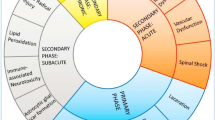Abstract
Intraoperative monitoring (IOM) of the motor pathways is a routine procedure for ensuring integrity of corticospinal tracts during scoliosis surgery. We have previously demonstrated presence of ipsilateral motor evoked potentials (MEPs) during IOM for scoliosis surgery, but its significance was uncertain. In this case series, we show concurrent ipsilateral and contralateral MEP amplitude changes obtained with cortical stimulation are of value in reducing false positive observations during IOM. The use of this easily recordable MEP is thus advocated as a diagnostic adjunct to contralateral MEPs for scoliosis and spinal surgery.
Similar content being viewed by others
References
Edgley SA, Jankowska E, Hammar I (2004) Ipsilateral actions of feline corticospinal tract neurons on limb motorneurons. J Neurosci 24:7804–7813
Hallett M. (2001) Functional reorganization after brain lesions of the human brain: studies with transcranial magnetic stimulation. Rev Neurol (Paris) 157:822–826
Hilbarnd AS, Schwartz DM, Sethuraman V, Vaccaro AR, Albert TJ. (2004) Comparison of transcranial electric motor and somatosensory evoked potential monitoring during cervical spine surgery. J Bone Joint Surg Am 86:1248–1253
Lo YL, Dan YF, Tan YE, Tan SB, Tan CT, Raman S. (2005) A prospective study of the utility of preoperative somatosensory evoked potentials in spinal surgery. Eur Spine J 14:521–522
Lo YL, Dan YF, Tan YE, Fook-Chong S, Tan SB, Tan CT, Raman S. (2006) Intraoperative monitoring study of ipsilateral motor evoked potentials in scoliosis surgery. Eur Spine J 15:656–560
Lyon R, Feiner J, Lieberman JA. (2005) Progressive suppression of motor evoked potentials during general anesthesia: the phenomena of “anesthetic fade”. J Neurosurg Anesthesiol 17:13–19
MacDonald DB, Streletz LJ, Al-Zayed Z, Abdool S, Stigsby B. (2004) Intraoperative neurophysiologic discovery of uncrossed sensory and motor pathways in a patient with horizontal gaze palsy and scoliosis. Clin Neurophysiol 115:576–582
Nathan PW, Smith MC, Deacon P. (1990) The corticospinal tracts in man. Course and location of fibers at different segmental levels. Brain 113:303–324
Conflict of interest statement
None of the authors has any potential conflict of interest.
Author information
Authors and Affiliations
Corresponding author
Rights and permissions
About this article
Cite this article
Lo, Y.L., Dan, Y.F., Teo, A. et al. The value of bilateral ipsilateral and contralateral motor evoked potential monitoring in scoliosis surgery. Eur Spine J 17 (Suppl 2), 236–238 (2008). https://doi.org/10.1007/s00586-007-0498-4
Received:
Accepted:
Published:
Issue Date:
DOI: https://doi.org/10.1007/s00586-007-0498-4




